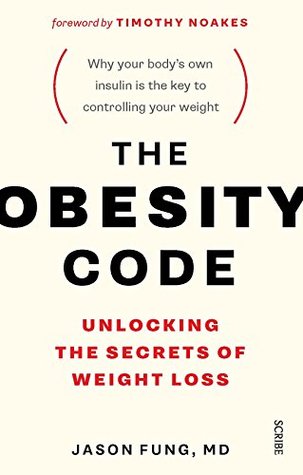I read this book based on a recommendation regarding eating fats. On the title alone, I probably would have ignored this book, but the contents is absolutely superb.
If you're interested in nutrition and how the human body works (and obesity/fat and type 2 diabetes) then this book is a superb match.
The majority of the book is dedicated to understanding the problems of food consumption and how it affects our bodies.
Importantly, the pages are chock full of references to real scientific studies that support the claims.
The last part of the book is dedicated to long term maintenance and long term change (since all diets eventually fail due to the body adjusting it's energy expenditure for the calories being consumed). This is where the studies are a little thinner on the ground, bug Fung uses logic to argue his case (there are some studies, but not as such high frequency as the rest of the book).
All in all, this book has changed my views on dietary fats, helped me understand why we get fat and finally shown me why fasting works.
Highly recommended.
26 Highlight(s)
THREE MEALS A DAY. NO SNACKS.
There are essential fatty acids, such as the omega 3 and omega 6 fats, and essential amino acids, such as phenylalanine, valine and threonine. But there are no essential carbohydrates and no essential sugars. Those are not required for survival.
The insulin index, created by Susanne Holt in 1997, measures the rise in insulin in response to a standard portion of food,
Remember that the single defining characteristic of the Western diet is food processing, not macronutrient content. The toxicity lies not in the food, but in the processing.
It is now increasingly recognized that the low-fat campaign has been based on little scientific evidence and may have caused unintended health consequences. HARVARD RESEARCHERS DRS. FRANK HU & WALTER WILLETT, 2001
saturated fat was dangerous, but mono-unsaturated fats were protective.
Cholesterol is a key building block in the membranes that surround all the cells in our body. In fact, it's so vital that every cell in the body except the brain has the ability to make it. If you reduce cholesterol in your diet, your body will simply make more.
A comprehensive review of all the studies of high-fat dairy finds no association with obesity,
In the short term, we can use various diets to bring our actual body weight down. However, once it falls below the body set weight, the body activates mechanisms to regain that weight—and that's the long-term problem. This resistance to weight loss has been proven both scientifically and empirically.2
The truth is that there are multiple overlapping pathways that lead to obesity.
Rice cakes, advertising themselves as low fat, compensate for lack of taste with sugar.
like snacks, breakfast foods are often little more than dessert in disguise, containing vast quantities of highly processed carbohydrates and sugar.
In the diets of children under age eight, breakfast cereals rank behind only candy, cookies, ice cream and sugared drinks as a source of dietary sugar.
Coffee, even the decaffeinated version, appears to protect against type 2 diabetes. In a 2009 review, each additional daily cup of coffee lowered the risk of diabetes by 7 per cent, even up to six cups per day.
THERE ARE FIVE basic steps in weight loss: 1.Reduce your consumption of added sugars. 2.Reduced your consumption of refined grains. 3.Moderate your protein intake. 4.Increase your consumption of natural fats. 5.Increase your consumption of fiber and vinegar.
High insulin maintains our high body set weight.
GLUCOSE AND FAT are the body's main sources of energy. When glucose is not available, then the body adjusts by using fat, without any health detriment.
The transition from the fed state to the fasted state occurs in several stages:3
Many people worry that fasting may cause malnutrition, but this concern is misplaced. The body's fat stores are, for most of us, quite ample for our bodies' needs.
There is another persistent myth that brain cells require glucose for proper functioning. This is incorrect. Human brains, unique among animals, can use ketones as a major fuel source during prolonged starvation, allowing the conservation of protein such as skeletal muscle.
The body had started to switch over from burning sugar to burning fat, with no overall drop in energy. Four days of continuous fasting actually increased total energy expenditure by 12 per cent.20
In an extreme case, in 1973, physicians monitored a man during a 382-day therapeutic fast. Originally weighing 456 pounds, he finished his fast at 180 pounds. No electrolyte abnormalities were noted throughout the period, and the patient felt well throughout.29
The defining characteristic of life on Earth is homeostasis. Any constant stimulus will eventually be met with an adaptation that resists the change. Persistent exposure to decreased calories results in adaptation (resistance); the body eventually responds by reducing total energy expenditure, leading to the dreaded plateau in weight loss and eventually to weight regain.
We cannot feast all the time. We cannot fast all the time. It won't work. It doesn't work.
Reduce intake of refined grains and sugars, moderate protein consumption and increase natural fats. Maximize protective factors such as fiber and vinegar. Choose only natural, unprocessed foods.
The original intent of the fight-or-flight response was to mobilize the body for physical exertion. Exercise can also release endorphins and improve mood. This benefit far exceeds the relatively modest caloric reduction achieved by exercise.
